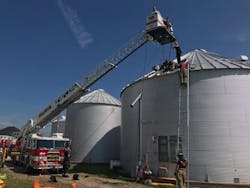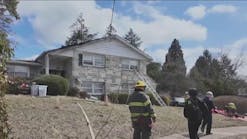May 30, 2018, started out like any other Wednesday at the Burlington, IA, Fire Department (BFD). Two ambulance calls were just wrapping up, and our downtown engine company had recently returned from a standby at a chlorine tank change-out at Burlington’s water treatment plant. Weekly maintenance on our department’s sole aerial truck had just started when the tones dropped. At a family farm west of town, a man was trapped up to his neck inside of a grain bin. Central Station roared to life as firefighters of all ranks descended upon their respective vehicles as fast as possible. BFD was en route to its first grain bin rescue in department history.
Initial actions
Initial response consisted of two ambulances that had just cleared from calls, one command vehicle, one aerial platform truck, our first-due engine, our second-due rural engine, our chief and deputy chief in their vehicles, and one “workhorse” pickup truck pulling our Special Operations Trailer. Other responding agencies included the West Burlington Fire Department, Mediapolis Fire Department, Des Moines County Sheriff’s Department, Medforce Aeromedical Transport, and Des Moines County Secondary Roads.
The initial-arriving unit, which was the closest ambulance at the time, made contact with the son of the entrapped victim. The son, who was on the roof of the bin, advised the two firefighter-paramedics that his father was buried up to his armpits inside of the bin. The bin is designed to hold an estimated capacity of 30,000 bushels of corn and was two-thirds full of corn that morning. The son had thrown a rope down to his father to hold to prevent slipping down into the corn. The victim was calm and able to communicate, but the first-arriving team of Firefighters Garrett Johnson and Ky Duttlinger wanted to be ahead of any medical complications, so they used a Res-Q-Throw Disc typically used in water rescues to lower an oxygen bag with an attached non-rebreather mask to the victim.
The next few minutes were a flurry of arriving vehicles, and the positioning of these vehicles was integral to the overall positive outcome of the incident. Our aerial truck was positioned in the narrow lane between two grain bins and a barn while crews made short work of setting it up for operation.
The command car arrived on the scene shortly thereafter, and Battalion Chief Bruce Workman assumed command, a position he held throughout the duration of the incident. The command post was set up a short distance behind the aerial, offering the greatest possible vantage of operations commencing on the roof and offering a view of a small lane that circled around to the backside of the structure.
The aerial was extended to conduct a face-to-face with the crews on the roof, which by then consisted of two firefighters and two deputies as well as the victim’s son. The son and one of the deputies recused themselves from the roof to decrease the number of people on top of the structure. It was clear at that time that the only way forward in this operation was to set up a rope system and lower a responder into the bin. The aerial was bedded to prepare for this operation.
Rescue play by play
The Special Operations Trailer was pillaged and soon two life safety-rated ropes, designated main line and secondary line, were readied. Pulleys were attached to the manufactured anchor points on the bottom the aerial platform, and a change-of-direction was fixed to the front frame of the same truck, directing the pulling action of the rope to a large grassy area in front of the truck. The main line was eventually fitted with a 5-to-1 system while the secondary line remained a 2-to-1 system.
Firefighter Andy Crooks soon emerged from the throng as the coordinator of rope operations on the ground. CMC Rescue multi-purpose devices (MPDs) were used as the descent-control devices on both lines. These devices were highly praised by the on-scene personnel.
Firefighter Robert Berndt volunteered to enter the bin and make the rescue. Berndt was off duty that day but was at Central Station working out when the alarm sounded for the grain bin rescue. He, along with several off-duty officers, responded to the scene. Berndt donned a Class III harness and was lowered through a small opening in the top of the bin to the surface of the corn, approximately 25 feet below.
To lower him, the aerial platform was positioned above the opening, and the remaining department personnel on the roof tended to the lines. These personnel also aided in passing down equipment via rope to Berndt. The equipment was stored in the aerial platform until it was ready to be used. Among the equipment to be lowered with Berndt were several milk crates and pop bottle flats. The crates and flats were an essential part of the operation and distributed Berndt’s weight on the corn, allowing him to walk across the surface of the corn. Berndt arranged these pieces in a horse-shoe pattern around the victim to create a safe workplace for himself. A truck belt was also lowered into the bin, and Berndt was able to position it around the victim’s chest, which remained attached to the secondary line to prevent the victim from descending further into the corn.
Finally, the six-paneled grain rescue tube was lowered panel by panel into the bin. The panels were set, one at a time, around the victim and then beat into place with a TNT Rescue tool. The panels were then fastened to each other to form a solid tube. This tube, when secured, protected the victim from shifting corn and relieved some of the pressure exerted on him by the corn from all sides. Throughout this process, the ropes ground team kept Berndt on a short leash to prevent him from falling into the grain himself.
Atmospheric monitoring was conducted from the grain bin roof via department four-gas meter with an extra-long sampling tube. Crews wanted to ensure that in the victim and the firefighter weren't operating in an IDLH atmosphere and the monitor provided a clearer picture of conditions inside. Captain Scott Hoschek kept a continuous eye on the meter and was positioned on an extension ladder on the exterior of the bin near the opening where Berndt had entered, functioning as a safety officer for operations inside the bin and on the roof. Hoschek also provided communication between Berndt and the crews working outside of the bin.
Mediapolis Fire Department brought with them a special grain rescue auger that was lowered into the bin. Berndt inserted the auger inside the tube and the auger slowly and steadily removed the corn from around the victim’s chest. After the tube was secured around the victim, Command called for two relief cuts to be made in the bin—one near where the victim was positioned and the other directly opposite it on the other side of the bin—to effectively empty it of corn. Crews then used K-12 saws to cut a large triangular opening in the wall of the grain bin. The second opening was made by forcing open a door in the side of the grain bin near the victim. The doors, which swung inward, could only be forced open after a significant amount of corn spilled out from the cut made to the other side.
The Des Moines County Secondary Roads crews had arrived shortly after BFD’s initial response. After consulting with Command, they brought a large end loader and a smaller skid loader to the scene and used them to push the copious amount of corn away from the openings in the walls, enabling a continuous flow of corn. The operation continued in this way until, approximately two hours and fifteen minutes after crews had arrived, the victim was able to walk out of the grain bin on his own two feet.
The victim refused aeromedical transport, but consented to ground ambulance transport to our nearby hospital for treatment of minor injuries.
Lessons learned
The department identified several lessons learned from this unique technical rescue:
· A grain bin rescue is a high-risk/low-frequency event. In recent years, training in this area has improved greatly at our department. Training with ropes and rope operations as well as additional training with the specialized equipment will be emphasized going forward.
· Characteristics of the construction of grain bins was discussed at length during our post-incident review. We learned that the roofs of grain bins hold far less weight than what we expected. While there was no indication of structural compromise while at the incident, at future incidents we plan on reducing the number of personnel on the roof as much as possible.
· We relied heavily on our aerial platform, not only for the anchor point of our operations inside the grain bin, but also as a holding area for all of our equipment being sent inside. At our post-incident review, we discussed the physical limitations of the platform, including its maximum load-bearing capacity and how that changes when ropes were used underneath it. While we weren’t in any danger at this incident, we were approaching the limits of the platform’s capabilities. Special care will be taken in the future to reduce the amount of weight in the platform and the angle at which it is extended.
Successful outcome
All told, the grain bin rescue was a tremendous success. The cooperation between various agencies, the recently upgraded rope equipment, and the training conducted for this type of specialized operation are all credited to the successful outcome. It also cannot be overstated that the victim and his son’s awareness of the dangers of the work they were doing and their reaction to the event were cornerstones for the success of his eventual rescue. It was a good day for BFD and a great day for the family we served.
Sidebar: About Burlington
The Burlington Fire Department is a 48-member career department that covers a diverse population, including urban and rural residential, farmland, approximately 14 miles of Mississippi River coastline, and a large variety of industries. The community relies on its fire department not just for fire protection, but also fire prevention and education, firefighter-paramedic-staffed ALS ambulances, technician-level hazardous material response, confined-space and high-angle rescue, river rescue, fire code inspections and enforcement, and aircraft rescue firefighting (ARFF).
Brandon Howard
Brandon Howard is a firefighter/paramedic with the Burlington, IA, Fire Department. In addition to his regular duties, he serves as vice president to IAFF Local 301, board president of the Southeast Iowa Critical Incident Stress Management team, and routinely serves his department as a public speaker and instructor in various capacities.






